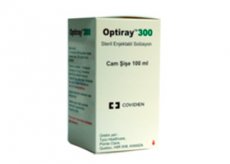Medical expert of the article
New publications
Preparations
Optireus
Last reviewed: 04.07.2025

All iLive content is medically reviewed or fact checked to ensure as much factual accuracy as possible.
We have strict sourcing guidelines and only link to reputable media sites, academic research institutions and, whenever possible, medically peer reviewed studies. Note that the numbers in parentheses ([1], [2], etc.) are clickable links to these studies.
If you feel that any of our content is inaccurate, out-of-date, or otherwise questionable, please select it and press Ctrl + Enter.

Optiray is a substance used in diagnostic procedures - to perform contrast X-rays. After introduction into the area of the vascular bed, the substance is secreted under X-ray radiation, thanks to which it is possible to study the state of the cardiovascular system.
After intravascular use of the drug, the blood flow containing the contrast element becomes opaque to X-rays. As a result, the circulatory system of internal organs acquires radiographic visualization (until the level of the contrast component decreases).
Indications Optirea
It is used in angiographic examination of vessels located in different areas of the body (peripheral, as well as cerebral and peritoneal), and in addition to this, in intravenous urography.
 [ 1 ]
[ 1 ]
Release form
The component is released in the form of a solution, inside 0.1 l bottles – 10 pieces inside a pack.
Pharmacokinetics
Less than 2% of the drug is synthesized with intraplasmic protein. The Cmax indicator of the element is recorded in the blood after 1 hour from the moment of application. Optiray is able to overcome the BBB and be excreted with breast milk.
The half-life after administration of a 0.15 L dose is approximately 2 hours.
Dosing and administration
The medication is administered intravenously or intra-arterially. It can be administered by jet or drip. The volumes of the element used are determined by the patient's age and weight, as well as the hemodynamic picture and the condition of the vascular area being examined. The patient must not eat for 2 hours before the diagnostics.
Dosages required for examination of different vascular areas:
- vertebral or carotid artery is injected with 2-12 ml of the substance;
- common iliac or femoral - in the range of 10-50 ml;
- brachial or subclavian – within 15-30 ml;
- inferior mesenteric artery or renal circulatory system – 6-15 ml;
- aortic bifurcation – 20-90 ml.
In case of venography, 30-80 ml of the drug is used, and for intravenous urography – 65-80 ml.
 [ 2 ]
[ 2 ]
Use Optirea during pregnancy
Pregnant women should not undergo hysterosalpingography.
Contraindications
Among the contraindications:
- severe sensitivity associated with the drug;
- thyrotoxicosis;
- renal or hepatic insufficiency;
- risk of developing epileptic seizures;
- breastfeeding period;
- active inflammation in the pancreas (in case of cholangiopancreatography procedure);
- inflammation affecting organs in the pelvic area;
- plasmacytoma of a generalized nature;
- severe forms of pathologies associated with cardiovascular diseases.
Side effects Optirea
Side effects usually occur immediately after taking the drug. Among them are: loss of consciousness, pain, burning and heat, decreased heart rate, visual disturbances, decreased blood pressure, heart rhythm disturbances and coronary heart disease. In addition, hemiparesis, nausea, itching, kidney dysfunction, encephalopathy, cyanoderma, edema or allergic rashes, as well as a discrepancy between the BCC and the volume of the vascular bed.
Local signs include tissue necrosis and vascular spasm.
Allergic reactions may develop several days after the procedure.
Overdose
Drug intoxication can lead to respiratory, renal, or cardiovascular failure.
Interactions with other drugs
Optiray should not be mixed with other medications. Analgesic drugs and psychotropics increase the risk of developing negative symptoms.
Hypoglycemic agents increase the likelihood of developing renal failure, which is why their use should be stopped 2 days before the examination.
The use of β-adrenergic agonists increases the risk of developing allergic reactions.
Leukocyte-type cytokines can provoke the development of rashes, fever, joint pain and itching.
Storage conditions
The Optiray should be stored in a place protected from sunlight. Temperature values are a maximum of 30°C.
Shelf life
Optiray can be used within a 36-month period from the date of sale of the medicinal product (a substance that has not been exposed to X-rays or frozen). The shelf life of substances stored inside a heater where air penetrates (37°C) is 1 month.
Application for children
Optiray is not used in pediatrics.
Analogues
The drug's analogue is the substance Ioversol.
Attention!
To simplify the perception of information, this instruction for use of the drug "Optireus" translated and presented in a special form on the basis of the official instructions for medical use of the drug. Before use read the annotation that came directly to medicines.
Description provided for informational purposes and is not a guide to self-healing. The need for this drug, the purpose of the treatment regimen, methods and dose of the drug is determined solely by the attending physician. Self-medication is dangerous for your health.

